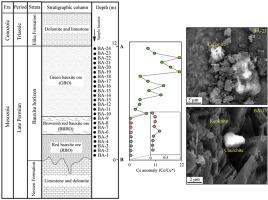当前位置:
X-MOL 学术
›
J. Afr. Earth Sci.
›
论文详情
Our official English website, www.x-mol.net, welcomes your
feedback! (Note: you will need to create a separate account there.)
Rare earth element geochemical characteristics of the late Permian Badamlu karst bauxite deposit, NW Iran
Journal of African Earth Sciences ( IF 2.2 ) Pub Date : 2020-12-01 , DOI: 10.1016/j.jafrearsci.2020.103974 Ali Abedini , Maryam Khosravi , Harald G. Dill
Journal of African Earth Sciences ( IF 2.2 ) Pub Date : 2020-12-01 , DOI: 10.1016/j.jafrearsci.2020.103974 Ali Abedini , Maryam Khosravi , Harald G. Dill

|
Abstract The Badamlu karst bauxite deposit, located 55 km southeast of Miandoab city in northwestern Iran occurs in karstic depressions of carbonates of the late Permian Nessen Formation. The studied bauxitic ores have a dominant pelitomorphic texture, and locally developed ooidic, pisoidic, and clastic textures in a pelitomorphic matrix. Mineralogically, the bauxite ores are composed mostly of diaspore, hematite, and kaolinite, as well as lesser amounts of rutile, chlorite, goethite, and illite. In addition, REE minerals, such as churchite and cerianite were detected. Cerianite occurs in the core of ooids, and churchite is surrounded by a kaolinite-rich matrix. Churchite and cerianite formed in acidic and oxidizing conditions in the uppermost part of the weathered profile, respectively. Total rare earth elements La-Lu contents in the bauxite ores range widely from 29.1 to 2138.2 ppm (average = 746.5 ppm, std = 722.3 ppm), with Ce being the dominant REE (1.3–1825.0 ppm, average = 606.7 ppm, std = 645.1 ppm). The ΣREE contents, (LREE/HREE)ch ratio, and Ce anomaly in the bauxite ores increase upward through the profile, in which LREE and HREE are La–Eu and Gd–Lu, respectively. The Ce anomaly in the bauxite ores has a bimodal distribution with higher Ce anomalies in the upper 7.5–m-thick succession (2.7–20.8, average 10.5), compared to the lower and middle 4.5–m-thick succession (0.1–0.3, average 0.1). The downward decrease in the Ce anomaly may be due to the lack of cerianite and a decrease in the oxidation state. The REE distribution patterns normalized to chondrite exhibit a variable depletion/enrichment of LREE and HREE, with a negative Eu anomaly (0.3–0.7).
中文翻译:

伊朗西北部晚二叠世巴达姆鲁岩溶铝土矿床稀土元素地球化学特征
摘要 巴达姆鲁岩溶铝土矿矿床位于伊朗西北部米安多布市东南55公里处,产于晚二叠世内森组碳酸盐岩溶洼地。所研究的铝土矿具有显着的泥质质结构,在泥质基质中局部发育鲕粒质、豆质质和碎屑质结构。在矿物学上,铝土矿主要由硬水铝石、赤铁矿和高岭石组成,以及少量的金红石、绿泥石、针铁矿和伊利石。此外,还检测到 REE 矿物,如教堂长石和铈锆石。Cerianite出现在鲕粒的核心,而教堂石被富含高岭石的基质包围。在酸性和氧化条件下分别在风化剖面的最上部形成了丘长石和蜡长石。铝土矿中的总稀土元素 La-Lu 含量范围从 29.1 到 2138.2 ppm(平均值 = 746.5 ppm,std = 722.3 ppm),其中 Ce 是主要的 REE(1.3-1825.0 ppm,平均值 = 606.7 ppm,std = 645.1 ppm)。铝土矿中的ΣREE含量、(LREE/HREE)ch比和Ce异常通过剖面向上增加,其中LREE和HREE分别为La-Eu和Gd-Lu。铝土矿中的 Ce 异常呈双峰分布,上部 7.5 米层序(2.7-20.8,平均 10.5)中的 Ce 异常较高,而下部和中间 4.5 米层序(0.1-0.3,平均 0.1)。Ce异常的下降可能是由于缺乏铈铈矿和氧化态的降低。归一化为球粒陨石的 REE 分布模式表现出 LREE 和 HREE 的可变消耗/富集,
更新日期:2020-12-01
中文翻译:

伊朗西北部晚二叠世巴达姆鲁岩溶铝土矿床稀土元素地球化学特征
摘要 巴达姆鲁岩溶铝土矿矿床位于伊朗西北部米安多布市东南55公里处,产于晚二叠世内森组碳酸盐岩溶洼地。所研究的铝土矿具有显着的泥质质结构,在泥质基质中局部发育鲕粒质、豆质质和碎屑质结构。在矿物学上,铝土矿主要由硬水铝石、赤铁矿和高岭石组成,以及少量的金红石、绿泥石、针铁矿和伊利石。此外,还检测到 REE 矿物,如教堂长石和铈锆石。Cerianite出现在鲕粒的核心,而教堂石被富含高岭石的基质包围。在酸性和氧化条件下分别在风化剖面的最上部形成了丘长石和蜡长石。铝土矿中的总稀土元素 La-Lu 含量范围从 29.1 到 2138.2 ppm(平均值 = 746.5 ppm,std = 722.3 ppm),其中 Ce 是主要的 REE(1.3-1825.0 ppm,平均值 = 606.7 ppm,std = 645.1 ppm)。铝土矿中的ΣREE含量、(LREE/HREE)ch比和Ce异常通过剖面向上增加,其中LREE和HREE分别为La-Eu和Gd-Lu。铝土矿中的 Ce 异常呈双峰分布,上部 7.5 米层序(2.7-20.8,平均 10.5)中的 Ce 异常较高,而下部和中间 4.5 米层序(0.1-0.3,平均 0.1)。Ce异常的下降可能是由于缺乏铈铈矿和氧化态的降低。归一化为球粒陨石的 REE 分布模式表现出 LREE 和 HREE 的可变消耗/富集,











































 京公网安备 11010802027423号
京公网安备 11010802027423号